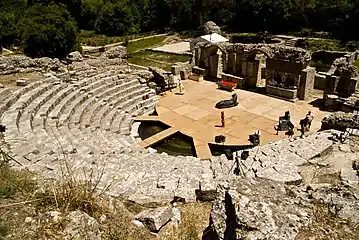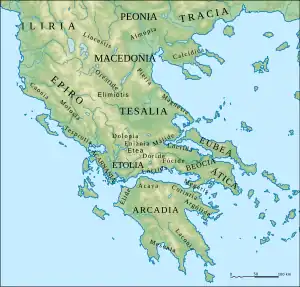| Chaonia (Χαονία) | |
|---|---|
| Region of Ancient Greece | |
 Theatre of Buthrotum | |
| Location | Northern/Northwestern Epirus |
| Tribal state (later subdivision of Epirus) | 8th–2nd centuries BC |
| Language | Northwestern Greek |
| Capital | Phoenice |
 | |
Chaonia or Chaon (Ancient Greek: Χαονία or Χάων) was the name of the northwestern part of Epirus, the homeland of the Epirote Greek tribe of the Chaonians.[1][2] It was one of the three main areas of ethnic division of Epirus, the other being Molossia and Thesprotia.[3]
Chaonia traditionally stretched between the Thyamis river in the south and the Akrokeraunian range in the north,[4] between present-day Greece and Albania. Its main town was called Phoenice. In Virgil's Aeneid, Chaon was the eponymous ancestor of the Chaonians.[5]
Name
According to mythology, the eponymous ancestor of the Chaonians was Chaon. Etymologically, both the region of Χαονία 'Chaonia', and the name of its inhabitants Χάονες 'Chaones, Chaonians', derive from Χάων 'Chaon', which in turn derives from the Greek *χαϝ-ών 'place with abysses'; cf. Χάον ὄρος 'Chaon mountain' in Argolis, χάος 'chaos, space, abyss', χάσκω 'to yawn', χάσμα 'chasm, gorge'.[6]
Geography
Strabo in his Geography,[7] places Chaonia between the Ceraunian mountains in the north and the River Thyamis in the south. The Roman historian, Appian, mentions Chaonia as the southern border in his description and geography of Illyria.[8]
Important cities in Chaonia included Cestrine (modern Filiates), Chimaera (modern Himarë), Buthrotum, Phoenice, Cassiope (Modern Kassiopi) Panormos, Ilium (modern Despotiko) Onchesmus (modern Sarandë), Antigonia and Palaeste.
Mythology
In Vigil's Aeneid, Aeneas visits Chaonia and meets Andromache and Helenus. He is told he must continue on to Italy, and instructed to meet the Sibyl concerning a more specific prophecy as to Aeneas's destiny.[9]
See also
References
Citations
- ↑ Errington, Malcolm. A History of Macedonia. University of California Press, 1990.
- ↑ The Cambridge Ancient History: Vol. 6, the Fourth Century BC.
- ↑ Chapinal-Heras 2021, p. 20.
- ↑ Chapinal-Heras 2021, p. 21.
- ↑ Virgil. Aeneid, 3.
- ↑ Georgiev, Vladimir Ivanov (1981). Introduction to the History of the Indo-European Languages. Publishing House of the Bulgarian Academy of Sciences. p. 156. ISBN 978-953-51-7261-1.
- ↑ Strabo. The Geography. Book VII, Chapter 7.5 (LacusCurtis).
- ↑ Appian. The Foreign Wars, III.1 (ed. Horace White).
- ↑ Virgil (1993). Aeneid. Translated by Fitzgerald, Robert. New York: Alfred A. Knopf. ISBN 0-679-41335-9.
Bibliography
- Chapinal-Heras, Diego (2021). Experiencing Dodona: The Development of the Epirote Sanctuary from Archaic to Hellenistic Times. Berlin and Boston: Walter de Gruyter GmbH & Co KG. ISBN 9783110727593.